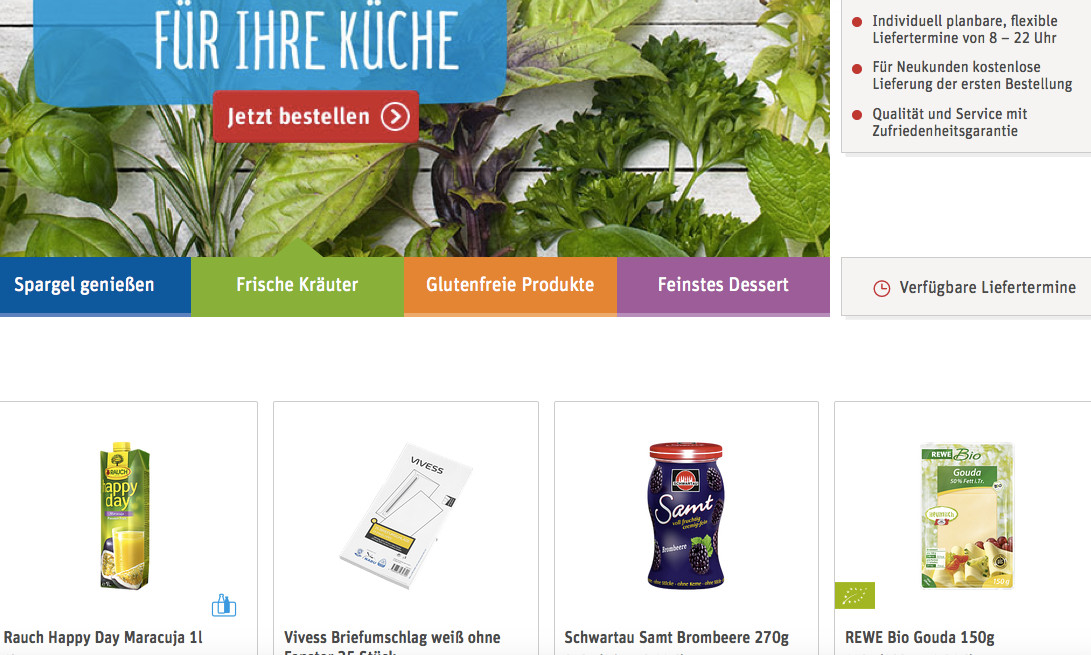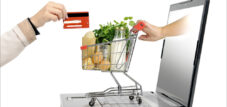Delivery vs. Click & Collect
For many people, having to go to the supermarket to buy pizza or pasta for dinner after a hard day at work is an unappealing idea. Of course, things can now be done differently, as buying groceries online is already a given in many places. While England and France are shining with high growth rates, other European countries are still in the starting blocks. This also includes – still – Germany, where buying food online is still a marginal phenomenon despite high growth figures. However, this can change quickly, as many grocery retailers are now relying on online shop solutions to meet the e-commerce competition that is emerging.
The customer rewards these efforts. According to studies, over 60 percent of consumers find it practical to buy everyday items online. In addition to a user-friendly website and competitive prices, smoothly running intralogistical processes are among the central success factors for a functioning online grocery store. But what about the delivery of the goods?
Also interesting for you?
- Buffer storage: For e-commerce, retail and manufacturing industries
- High-bay warehouse consulting & planning: Automatic high-bay warehouse – optimize pallet warehouse fully automatically – warehouse optimization
Transporting food by truck does not only have advantages.
In Germany, retailers like Rewe and Edeka primarily rely on truck transport for their goods. For customers, this has the advantage of delivering their ordered products directly to their homes, saving them a trip to the supermarket. However, it also presents them with one of the main problems in e-commerce delivery: accepting the delivery, which the recipient must be home to receive unless they have specified an alternative address. Unlike regular parcels, supermarket deliveries can't simply be left at the corner kiosk, as there's highly unlikely to be a suitable place to temporarily store temperature-sensitive items like dairy products or frozen food. To avoid this, a precise delivery date is essential for both retailers and consumers. This, in turn, creates additional logistical challenges for the sender, on top of the already incurred transport costs. Here, it's primarily the expenses for personnel (drivers) and vehicles (trucks, fuel) that complicate the retailer's calculations. Because one thing is certain: if the transport surcharge on the online order is too high, the customer will abandon the purchase. Given the low margins prevalent in the German food retail sector, this presents a dilemma for retailers. At the same time, it's also one reason why online grocery shopping hasn't yet taken off, and why a major player like Amazon with its Fresh delivery service in Germany.
However, there is an alternative that at least partially relieves retailers and consumers of transport costs and delivery problems: Click & Collect – ordering online and later picking up in the store, following the model of the classic drive-in system.
Suitable for:
Drive-in – the alternative?
The principle of the drive-in is simple and comparable to the concept known from burger chains: Orders are placed online, picked up by car at a pre-selected station, where the (cooled) bag is simply handed over to the driver without him even having to enter the store.
These drive-through grocery stores are a system that is gaining increasing popularity. In France, for example, over 2,000 drive-through supermarkets already offer their groceries online, which customers then pick up on-site, already prepared. The US supermarket chain Walmart , significantly expanding its Click & Collect service in 2016 (initially only in the US).
The completed boxes are then temporarily stored until the customer picks up the goods. Since an order usually consists of products of varying quality and shelf life, special requirements are placed on their storage. It must be ensured that refrigerated or even deep-frozen storage is available for individual items.
Depending on the ceiling height of the warehouse, the storage equipment used, some of which is climate-controlled, can be either horizontal carousel storage systems or vertical carousel racks. Shelving units can be combined with these as needed and as space allows.
The drive-in supermarket's intralogistics processes are controlled by warehouse management software. As soon as the software receives an order, the orders are routed to the various storage zones. In zones with automated storage and retrieval systems, the groceries are retrieved and received by staff at the service hatch according to the goods-to-person principle, where they are packed into the order container. To prevent picking errors or repetitions, each item is confirmed by the employees using a barcode scanner. Order processing can be further accelerated by using batch picking and/or multi-user picking tools.
Once an order is processed, the products are temporarily stored in a box/bag, with temperature-sensitive items kept in a refrigerated area or storage unit with integrated climate control. As soon as the customer arrives at the supermarket with their car, they simply scan a receipt code at one of the two parking bay scanner stations. An employee then retrieves the goods from the temporary storage area and brings them to the car. After the shopping is loaded, the customer can drive off without leaving their vehicle.
Conclusion
If the drive-in station is located on or near the customer's usual route home, the system results in virtually no time loss for the customer. And unlike delivery by driver, which is not always predictable in terms of timing, the customer can decide when to pick up the goods. Certainly, the success of such a system hinges on the widespread availability of drive-in stations, as customers would not be willing to go out of their way for this service. However, the success in France demonstrates the potential of this concept.
For the retailer, in addition to (one-time) investments in the interim storage facility and the on-site drive-through solution, labor costs for employees involved in goods handover must be factored in. However, this eliminates the costs for the logistical infrastructure required to transport the goods to the customer. Ultimately, the individual calculations of both the retailer and the customer will determine which solution they each consider more advantageous.
Xpert.Plus warehouse optimization consulting for Click & Collect and suitable distribution warehouse solutions.
Xpert.Plus is a project from Xpert.Digital. We have many years of experience in supporting and advising on storage solutions and in warehouse optimization , which we bundle in a large network Xpert.Plus
I would be happy to serve as your personal advisor.
You can contact me by filling out the contact form below or simply call me on +49 89 89 674 804 (Munich) .
I'm looking forward to our joint project.
Xpert.Digital – Konrad Wolfenstein
Xpert.Digital is a hub for industry with a focus on digitalization, mechanical engineering, logistics/intralogistics and photovoltaics.
With our 360° business development solution, we support well-known companies from new business to after sales.
Market intelligence, smarketing, marketing automation, content development, PR, mail campaigns, personalized social media and lead nurturing are part of our digital tools.
You can find out more at: www.xpert.digital – www.xpert.solar – www.xpert.plus


